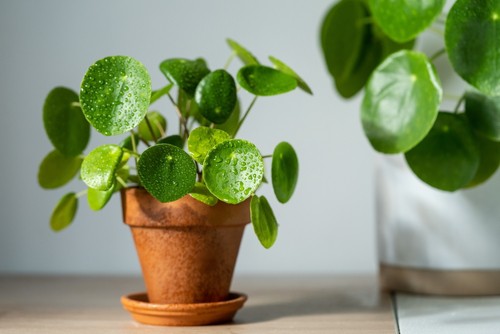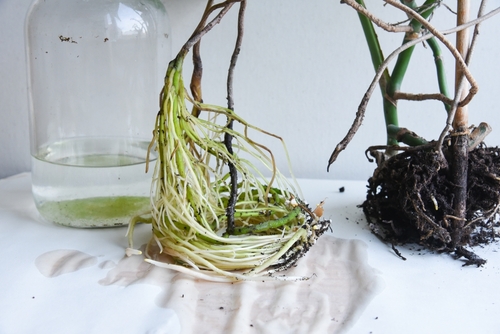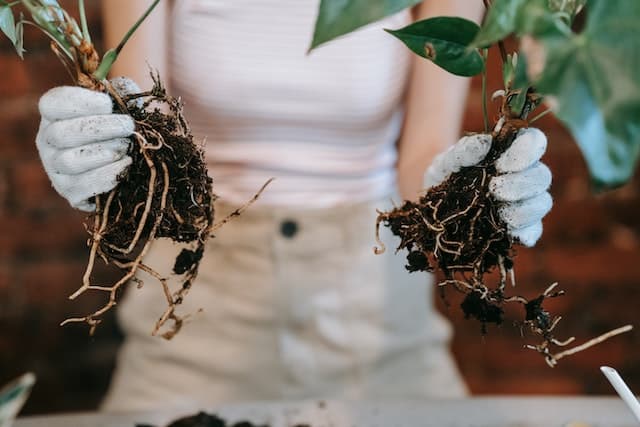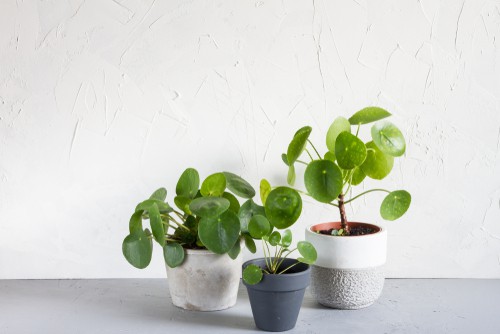Chinese money plants, also known as Pilea peperomioides, are becoming increasingly popular houseplants due to their unique round leaves and easy-to-care-for nature. However, despite their resilience, these plants can still become sickly and start to wilt. If you notice that your Chinese money plant dying, it’s important to take action quickly to save it.
Identifying the signs of a dying Chinese money plant is the first step in reviving it. Common signs of a dying plant include drooping stems and leaves, yellowing leaves, brown spots on leaves, and slow or no growth.
Once you’ve identified that your plant is struggling, it’s important to determine the cause of the problem. Common causes for a dying Chinese money plant can include lack of sunlight, overwatering, underwatering, root and soil issues, nutrient deficiencies, over fertilizing, and pests.
Understanding the ideal environment for a Chinese money plant is key to preventing it from dying in the first place. These plants prefer bright, indirect sunlight and well-draining soil. They also prefer to be kept slightly moist, but not overly wet.
By providing your plant with the right environment and addressing any issues as soon as they arise, you can help ensure that your Chinese money plant thrives.
Key Takeaways
- Identifying signs of a dying Chinese money plant is crucial to saving it.
- Common causes for a dying Chinese money plant include lack of sunlight, overwatering, and pests.
- Providing the ideal environment and addressing issues quickly can help your Chinese money plant thrive.
Don’t miss out on these other related posts:
Identifying Signs of a Dying Chinese Money Plant

Chinese Money Plants, also known as Pilea Peperomioides, are popular houseplants due to their unique round leaves and easy-to-care-for nature. However, even with proper care, they can still become sickly and start to wilt. In this section, we will discuss the signs of a dying Chinese Money Plant.
1. Yellowing Leaves
One of the most common signs of a dying Chinese Money Plant is yellowing leaves. This is usually caused by overwatering, which can lead to root rot. It can also be a sign of underwatering, nutrient deficiency, or pest infestation. If the yellowing leaves are accompanied by a mushy stem, it may be too late to save the plant.
2. Drooping Appearance
Another sign of a dying Chinese Money Plant is a drooping appearance. This is usually caused by a lack of water or too much direct sunlight. Chinese Money Plants prefer bright, indirect light, so if they are placed in direct sunlight, they may start to droop.
If the soil is dry, it may be time to water the plant. However, if the soil is wet, the drooping may be a sign of overwatering.
3. Brown Spots and Discoloration
Brown spots and discoloration on the leaves of a Chinese Money Plant can be a sign of a fungal or bacterial infection. It can also be a sign of nutrient deficiency or pest infestation. If the brown spots are accompanied by a foul smell or a slimy texture, it may be too late to save the plant.
4 Leggy Plant
A leggy Chinese Money Plant is a sign that it is not getting enough light. This can be caused by placing the plant in a location with insufficient light or not rotating the plant regularly. Leggy plants can be saved by moving them to a location with brighter, indirect light and rotating them regularly.
Chinese Money Plant Dying – 5 Common Problems
Chinese money plants, also known as Pilea peperomioides, are popular houseplants due to their unique coin-shaped leaves and ease of care. However, despite their hardiness, these plants can still experience issues that lead to their demise. In this section, we will explore the most common causes for a dying Chinese money plant.
1. Overwatering
Overwatering is one of the most common causes of a dying Chinese money plant. When the soil is consistently too wet, it can lead to root rot, which can ultimately kill the plant. Signs of overwatering include yellowing leaves, mushy stems, and a foul odor coming from the soil.
To avoid overwatering, it is important to allow the soil to dry out between watering sessions. A good rule of thumb is to water the plant when the top inch of soil feels dry to the touch. Additionally, make sure the plant is in a well-draining pot and avoid leaving it in standing water.
2. Underwatering
On the other hand, underwatering can also cause a Chinese money plant to die. When the soil is too dry, the plant cannot absorb the necessary nutrients and water to survive. Signs of underwatering include drooping leaves, brown leaf tips, and a dry, cracked soil surface.
To prevent underwatering, make sure to water the plant regularly, especially during the warmer months when the plant is actively growing. However, be careful not to overwater as well, as this can lead to the issues mentioned above.
3. Direct Sunlight Exposure
Chinese money plants prefer bright, indirect sunlight. However, too much direct sunlight can cause the leaves to burn and turn brown. On the other hand, too little light can cause the plant to become leggy and droopy.
To prevent direct sunlight exposure, place the plant in a location that receives bright, indirect sunlight. If the plant is receiving too much direct sunlight, consider moving it to a shadier location or using a sheer curtain to filter the light.
4. Pest Infestation

Chinese money plants can be susceptible to pests such as mealybugs and spider mites. These pests can cause damage to the leaves and stems, ultimately leading to the plant’s death.
To prevent pest infestations, regularly inspect the plant for any signs of pests, such as webs, white spots, or discoloration. If pests are present, treat the plant with an appropriate insecticide or try natural remedies such as neem oil or insecticidal soap.
5. Temperature Fluctuations
Chinese money plants prefer a temperature range of 60-75°F (15-24°C). Fluctuations outside of this range, such as exposure to extreme heat or cold, can cause the plant to suffer and eventually die.
To prevent temperature fluctuations, keep the plant in a location with consistent temperatures and avoid placing it near drafty windows or doors. Additionally, be mindful of the temperature when transporting the plant, such as during a move or when bringing it home from the store.
Understanding the Ideal Environment
Chinese money plants are relatively easy to care for, but they do require specific environmental conditions to thrive. Understanding these conditions is crucial to keeping your plant healthy and preventing it from dying.
Light Requirements
Chinese money plants prefer bright, indirect sunlight. They can also tolerate low light conditions, but this may cause the plant to become leggy and droopy. If the plant is not receiving enough light, its leaves may also turn pale in color. It is important to avoid placing the plant in direct sunlight, as this can scorch the leaves.
Watering Needs
Overwatering is one of the most common causes of Chinese money plant death. These plants prefer well-draining soil and do not tolerate sitting in water for extended periods. On the other hand, underwatering can also cause problems.
The soil should be kept slightly moist, but not waterlogged. A good rule of thumb is to wait until the top inch of soil is dry before watering.
Temperature and Humidity Preferences
Chinese money plants prefer warm, humid environments. They should be kept in a room with a temperature between 65-75°F (18-24°C) and a humidity level of at least 50%. If the air is too dry, the plant may develop brown, crispy leaf edges. To increase humidity, the plant can be placed on a tray of pebbles filled with water, or a humidifier can be used.
Addressing Root and Soil Issues
Chinese money plants require well-draining soil to thrive. If the soil is too dense or compact, it can lead to root rot, which is a common issue that can cause the plant to die. Addressing root and soil issues is crucial in reviving a dying Chinese money plant.
Root Rot

Root rot occurs when the roots of the plant are constantly sitting in water or overly moist soil. This can lead to the roots becoming waterlogged and suffocating, which can eventually cause the plant to die. Signs of root rot include brown, mushy roots and a foul odor.
To address root rot, it is important to remove the plant from the pot and examine the roots. Any brown or mushy roots should be trimmed off with sanitized scissors. The plant should then be repotted in fresh, well-draining soil and placed in a pot with drainage holes. It is also important to avoid overwatering the plant in the future.
Improper Soil Type
Using the wrong type of soil can also lead to issues with a Chinese money plant. The plant requires well-draining soil that allows excess water to flow through and away from the roots. Using a soil that is too dense or compact can lead to root rot and other issues.
To address soil issues, it is important to use a well-draining soil mix when repotting the plant. Adding perlite or other gritty materials to the soil can also help improve drainage and prevent issues with water retention.
Repotting and Fresh Soil
Repotting a Chinese money plant can help address issues with root and soil health. It is recommended to repot the plant every 1-2 years, or when the roots have outgrown the pot. When repotting, it is important to use fresh soil that is well-draining and free of any contaminants or pests.
To repot the plant, gently remove it from the pot and examine the roots. Any brown or mushy roots should be trimmed off, and the plant should be placed in a pot with fresh soil. It is important to avoid overwatering the plant after repotting, as this can lead to issues with root rot.
Nutrient Deficiencies and Over Fertilizing
Identifying Nutrient Deficiency
Chinese Money Plants are sensitive to nutrient deficiencies, which can cause them to wilt, turn yellow, or drop leaves. The most common nutrient deficiencies in Chinese Money Plants are nitrogen, potassium, and phosphorus.
Nitrogen deficiency can cause leaves to turn yellow and stunt plant growth. Potassium deficiency can cause brown spots on leaves, while phosphorus deficiency can cause leaves to turn dark green.
To identify nutrient deficiencies, examine the plant’s leaves and compare them to a nutrient deficiency chart. If the chart indicates that the plant is deficient in a particular nutrient, add a fertilizer that is rich in that nutrient. Be careful not to over fertilize, as this can cause nutrient burn and damage the plant.
Avoiding Overfertilization
Overfertilization is a common problem with Chinese Money Plants. Over Fertilizing can cause nutrient burn, which can damage the plant’s roots and lead to stunted growth. To avoid overfertilization, follow the manufacturer’s instructions for the fertilizer you are using. Be sure to dilute the fertilizer as directed and apply it only when the plant is actively growing.
To avoid nutrient deficiencies and overfertilization, it is important to use a balanced fertilizer that contains all the essential nutrients. A balanced fertilizer will provide the plant with the nutrients it needs to grow and thrive without causing nutrient burn or other problems.
Proper Care Techniques

Chinese money plants are relatively easy to care for, but they can still experience problems if not looked after properly. Here are some tips for proper care techniques:
1. Pruning
Pruning is an important aspect of caring for Chinese money plants. It not only helps to keep the plant looking neat and tidy but also promotes new growth. Use pruning shears to remove any dead or yellowing leaves, making sure to cut as close to the stem as possible. This will help prevent any potential disease from spreading to other parts of the plant.
2. Watering
Proper watering is key to keeping Chinese money plants healthy. They prefer regular watering, but overwatering can lead to root rot. Water the plant when the top inch of soil is dry to the touch. It is important to ensure that the pot has good drainage to prevent water from collecting at the bottom of the pot.
3. Light Exposure
Chinese money plants thrive in bright, indirect light. They can also tolerate low light conditions, but this can cause the leaves to become smaller and less vibrant in color. Consider using a grow light if the plant is not receiving enough natural light. Keep the plant away from direct sunlight as this can scorch the leaves.
Dealing With Pests
Identifying Common Pests
Chinese Money Plants are vulnerable to pest infestations, which can cause significant damage to the plant. The most common pests that attack Chinese Money Plants are spider mites and mealybugs.
Spider mites are tiny, eight-legged insects that suck the sap from the plant, causing the leaves to turn yellow and fall off. Mealybugs, on the other hand, are small, white, cottony insects that feed on the plant’s sap and excrete a sticky substance that attracts ants.
To identify pest infestations, inspect the plant regularly for signs of damage, such as yellowing leaves, stunted growth, and sticky residue on the leaves.
Look closely at the undersides of the leaves for spider mites, which can be difficult to spot due to their small size. Mealybugs are easier to identify, as they leave behind a white, cottony residue on the plant.
Using Insecticidal Soap
If your Chinese Money Plant is being attacked by pests like spider mites or mealybugs, treat them immediately. One effective way to get rid of pests is by using insecticidal soap. Insecticidal soap is a natural, non-toxic solution that kills pests on contact.
To use insecticidal soap, mix one tablespoon of soap with one quart of water in a spray bottle. Spray the plant generously, making sure to cover both the tops and undersides of the leaves. Repeat the treatment every seven to ten days until the pests are gone.
It is important to note that insecticidal soap can harm beneficial insects like bees and ladybugs, so use it sparingly and only when necessary. Additionally, avoid using insecticidal soap on plants that are stressed or wilted, as it can cause further damage.
Propagating a Chinese Money Plant

Using Offshoots
One of the easiest ways to propagate a Chinese Money Plant is through offshoots. These are baby plants that grow from the main plant and can be separated once they have developed their own root system. To propagate using offshoots, follow these steps:
- Gently remove the offshoot from the main plant, making sure to keep its roots intact.
- Plant the offshoot in a small pot with well-draining soil.
- Water the plant thoroughly and place it in a bright, indirect light.
- Keep the soil moist but not waterlogged, and avoid overwatering.
Within a few weeks, the offshoot should start to grow new leaves and develop its own root system. Once it has outgrown its small pot, it can be transplanted to a larger pot.
Choosing the Right Pot
When propagating a Chinese Money Plant, it is important to choose the right pot. Small pots are best for baby plants, as they help prevent overwatering and allow the soil to dry out more quickly. As the plant grows, it can be transplanted to a larger pot.
When choosing a pot, make sure it has drainage holes to prevent water from accumulating in the soil. A pot with a diameter of 4-6 inches is ideal for a baby plant, while a larger plant may need a pot with a diameter of 8-10 inches.
It is also important to choose a pot with the right material. Ceramic or terracotta pots are good choices for Chinese Money Plants, as they are porous and allow air to circulate around the roots. Plastic pots can also be used, but they should have drainage holes to prevent waterlogging.
Conclusion
Chinese Money Plant or Pilea Peperomioides is a popular houseplant that can be prone to dying if not given proper care and attention. Lack of sunlight, overwatering, and pest infestations are some of the common reasons why a money plant may start to wilt and eventually die.
To prevent a money plant from dying, it is important to ensure that it is placed in a bright location with indirect sunlight. The soil should be well-draining and not waterlogged. Overwatering can lead to root rot and eventually death of the plant. It is recommended to water the plant once a week or when the soil feels dry to the touch.
Another common problem that can cause a money plant to die is pest infestations. Mealybugs and spider mites are common pests that can affect the health of the plant. It is important to regularly inspect the plant for any signs of infestation and take appropriate measures to control the pests.
In addition, it is important to ensure that the plant is not placed in extreme temperatures, as this can also cause the plant to wilt and die. If the plant is experiencing transplant shock, it is recommended to provide it with extra care and attention until it recovers.
Frequently Asked Questions
Why is my Chinese Money Plant dropping leaves?
Chinese Money Plants may drop leaves due to overwatering, underwatering, lack of humidity, or pests. If the plant is overwatered, the roots may rot, causing the leaves to wilt and fall off. If the plant is underwatered, the leaves may also wilt and fall off.
Lack of humidity can cause the leaves to dry out and drop off. Pests such as spider mites or mealybugs can also cause the leaves to fall off.
How do you revive a dying Chinese Money Plant?
To revive a dying Chinese Money Plant, you must first identify the problem. If the plant is overwatered, stop watering it for a while and make sure the soil is well-draining.
If the plant is underwatered, water it more frequently and make sure the soil is moist but not waterlogged. If the plant is suffering from pests, treat it with an insecticide. If the plant has root rot, cut off the affected roots and repot it in fresh soil.
What does an overwatered Chinese Money Plant look like?
An overwatered Chinese Money Plant may have yellowing leaves that are soft and mushy to the touch. The soil may also be waterlogged and have a foul smell. The plant may also be wilting and dropping leaves.
Why is my Chinese Money Plant leaves turning brown?
Chinese Money Plant leaves may turn brown due to underwatering, overwatering, too much direct sunlight, or pests. If the plant is underwatered, the leaves may dry out and turn brown.
If the plant is overwatered, the roots may rot, causing the leaves to turn brown. If the plant is exposed to too much direct sunlight, the leaves may scorch and turn brown. Pests such as spider mites or mealybugs can also cause brown spots on the leaves.
How do I know if my Chinese Money Plant has root rot?
If your Chinese Money Plant has root rot, the leaves may wilt and turn yellow or brown. The roots may also be mushy and have a foul smell. To check for root rot, gently remove the plant from its pot and inspect the roots. Healthy roots should be firm and white.
How often should I fertilize my Chinese Money Plant?
Chinese Money Plants should be fertilized once a month during the growing season (spring and summer). Use a balanced, water-soluble fertilizer and follow the instructions on the package. Do not fertilize during the winter months when the plant is dormant.

Hey, I’m Lisa and I’ve been an avid gardener for over 30 years. I love writing, talking and living in the garden! Feel free to connect with me on my socials below


